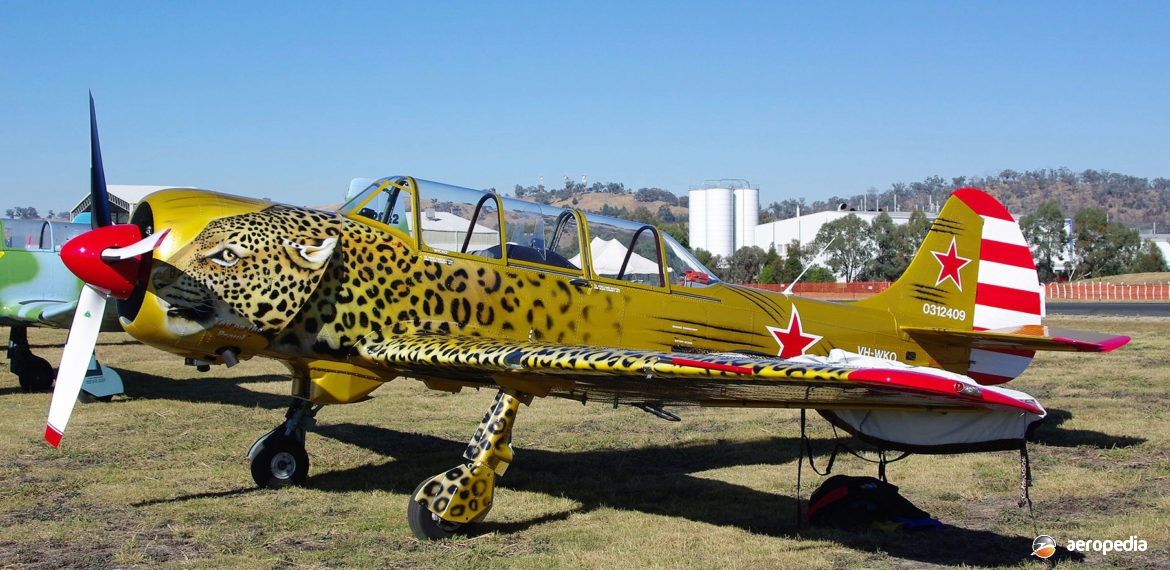Photograph:
Yak 52TW VH-WKO (c/n 0312409) at Albury, NSW in April 2008 (David C Eyre)
Country of origin:
Romania
Description:
Two-seat training and touring monoplane
Power Plant:
(Yak 52TW)
One 269 kw (360 hp) Vedeneyev M-14PF nine-cylinder supercharged air-cooled radial engine
Specifications:
- Wingspan: 9.9 m (32 ft 5¾ in)
- Length: 7.7 m (25 ft 3 in)
- Height: 2.5 m (8 ft 2 in)
- Wing area: 15.3 m² (163 sq ft)
- Max speed: 335 km/h (208 mph)
- Max cruising speed: 325 km/h (202 mph)
- Economical cruising speed (70% power): 250 km/h (155 mph)
- Stalling speed clean: 105 km/h (65 mph)
- Max rate of climb at sea level: 366 m/min (1,200 ft/min)
- Max ceiling: 4,000 m (13,000 ft)
- Range with 160 litres (35 Imp gals) of fuel: 600 km (373 miles)
- Range with 260 litres (57 Imp gals) fuel: 1,200 km (746 miles)
- Take-off run: 200 m (656 ft)
- Landing run: 260 m (853 ft)
- Empty weight: 950 kg (2,094 lb)
- Payload: 425 kg (937 lb)
- Loaded weight: 1,360 kg (2,998 lb)
History:
Since the availability of aircraft from the Eastern Bloc in the late 1970s some hundreds of Soviet-designed aircraft have become available to western pilots. Amongst these has been the Yak 52 series, particularly because they are cheap to buy, are excellent aerobatic machines and have some STOL performance, the operating costs being said to be half those of a Harvard and similar to a Stearman.
Over the years some changes were made to the design of the Yak 52 series, including rounded wingtips, flush riveting and the 298 kw (400 hp) variant of the Vedeneyev M-14PF engine. The type has been known for its sturdiness. It was of all-metal stressed skin construction, the covering using a special aluminium-zinc alloy, said to be stronger than duralumin. The flying control surfaces were fabric covered, the wing having a split flap, and fuel was carried in two wing tanks. All main services were pneumatically operated, including engine starting, flaps, undercarriage and brakes.
In 2000 the Aerostar facility in Romania modified a Yak 52 to tailwheel configuration as the Yak 52TW aimed particularly at the western market. The aircraft at that stage retained the main undercarriage doors still protruding below the wing. This new model first flew on 2 July 2001 achieving a maximum speed of 259 km/h (161 mph) and, when fitted with the 298 kw (400 hp) engine, achieved 311 km/h (193 mph). However, international certification was not obtained and the main market for the type was in the United States where it has been registered under the Experimental category.
Subsequently the Termikas organisation at its facility in Lithuania modified a Yak 52 to tailwheel configuration calling it the Yak 52TD. In this variant the undercarriage was fully retractable, retracting inwards. This company supplied aircraft fully converted, or provided a kit to modify an existing Yak 52 to the new configuration. The wings were modified to take extra fuel tanks, increasing capacity from 126 litres (28 Imp gals) to 270 litres (59.4 Imp gals) in the TD and 272 litres (59.8 Imp gals) in the TW.
The Yak 52TD with full fuel, two pilots and 50 kg (110 lb) of baggage could perform aerobatics at +6/-3G up to its max take-off weight, but reducing to 1,315 kg (2,899 lb) allowed the full +7/-5G to be used. The M-14PF radial engine produced 298 kw (400 hp) at 2,950 rpm but some engines have been modified to be able to produce 343 kw (460 hp) for special variants of the Sukhoi SU 26. Propellers fitted were usually either the variable pitch B530 TA D35 two-blade wooden unit, or the three-blade variable pitch Mulbauer MTV-9.
The first Yak 52TW was imported to Australia in 2004 by the distributor, Red Star Aviation, and since then further examples have been imported, the first becoming VH-YGR (c/n 0142403), followed by VH-POW (c/n 0412507) in September 2004 and VH-FYK (c/n 0412601) in July 2005. In 2008 a Yak-52TD was imported, becoming VH-XTD (c/n 790404) to its owner at Suffolk Park in July that year. More than 40 examples of the Yak 52 series have operated in Australasia.

